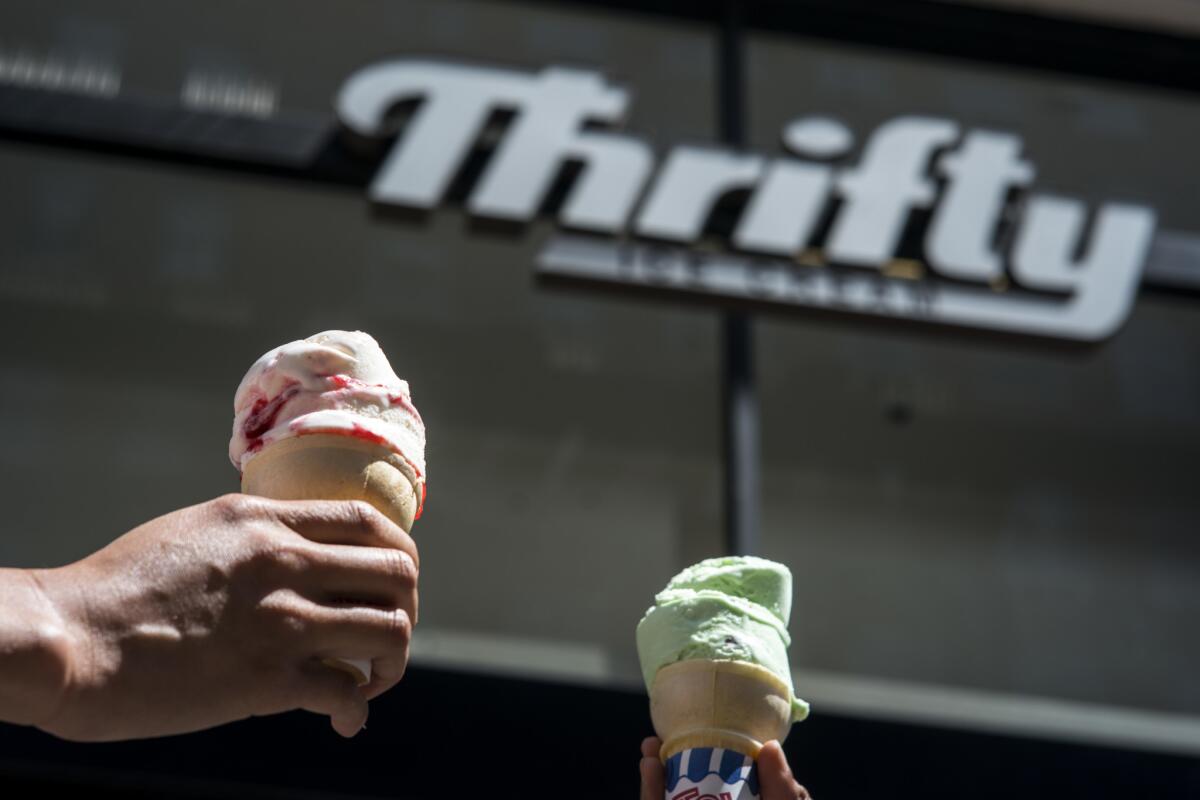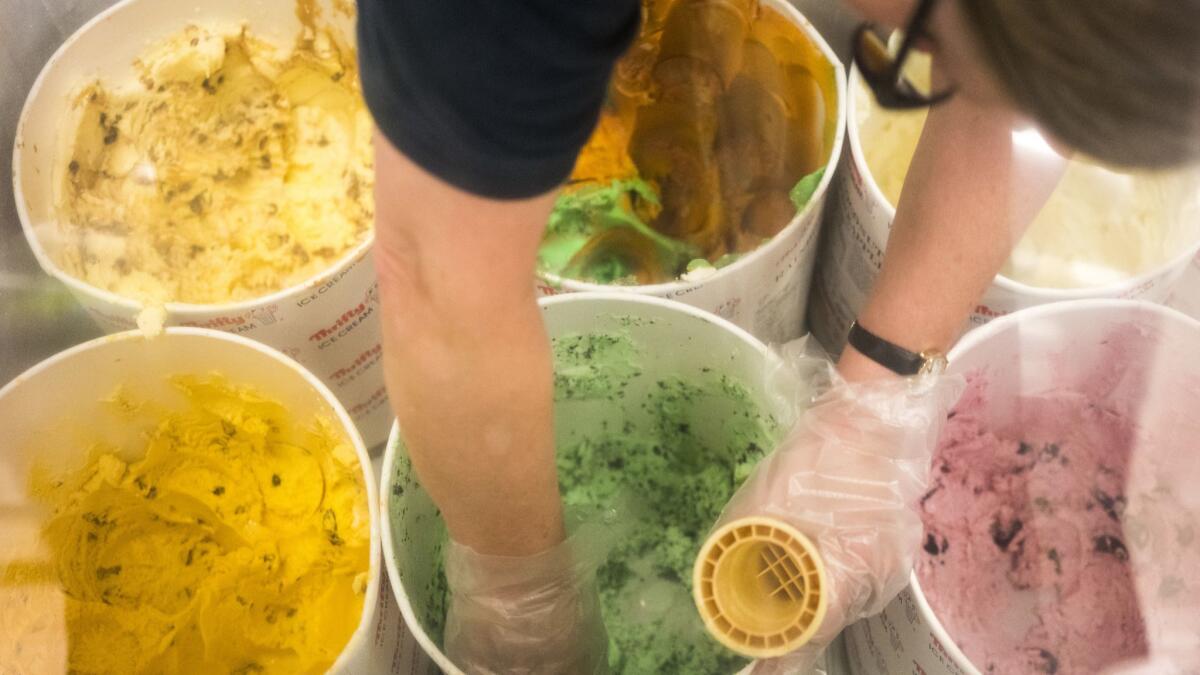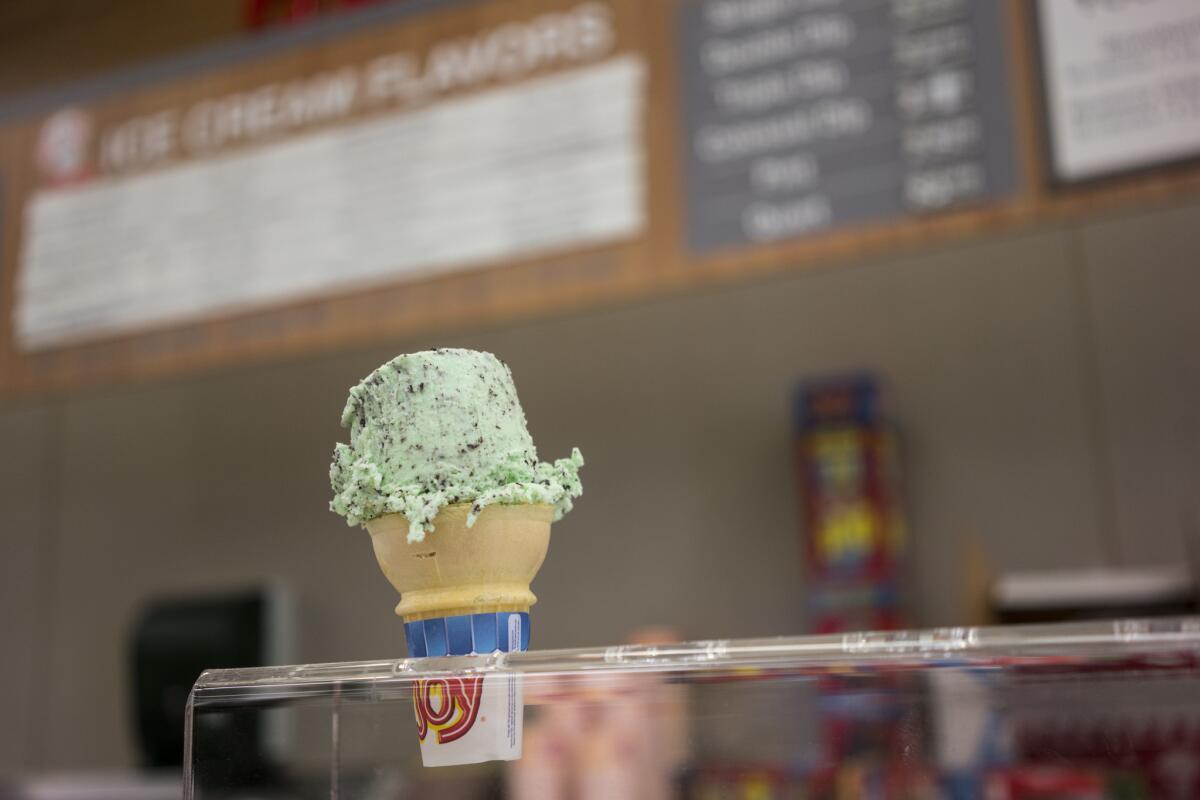Thrifty ice cream — a portal to childhood — is being sold to Albertsons. What does that mean for its future?

- Share via
When Mike Becker’s family visited Los Angeles this year, he took his three sons to a place that would help them understand his Southern California childhood. It wasn’t the beach. It wasn’t Hollywood. It was a drugstore selling Thrifty ice cream.
The 43-year-old attorney lives in New York, and he hadn't enjoyed a Thrifty cone since he was 10, when he moved out of Burbank. When he spotted the Thrifty logo outside a Rite Aid store in downtown L.A., Becker wanted to show his sons what he experienced growing up. He pulled over and parked. He hauled the kids into the store. He bought them the ice cream, dipped to order in Thrifty’s distinctive cylinder-shaped scoops.
“As a little kid, with change in your pocket, it was easy to get an ice cream cone,” Becker recalled. “It was so cheap.”
That mix of low prices and nostalgia, coupled with a reputation for tastiness — Thrifty ice creams are perennial medal winners at the L.A. County Fair — has fueled generations of devotion.
Thrifty ice cream “is the greatest power brand that any drugstore has created anywhere across America,” said Burt Flickinger, managing director of Strategic Resource Group, a retail consulting firm. “No matter what’s happened to the retailer over the years, the brand has always been a key foundation for the ongoing viability of Rite Aid because of the tremendous loyalty to Thrifty.”
Soon, a different kind of loyalty may be tested. In February, Albertsons Cos. — which owns grocery chains including Vons, Pavilions and Safeway — said it would acquire Rite Aid, a purchase that includes the Thrifty brand and the El Monte factory where the ice cream is made. A Rite Aid executive said Tuesday that Albertsons plans to keep the Thrifty brand alive and will sell the ice cream in its grocery stores. But the two companies did not answer questions about whether the ice cream will continue to be made in El Monte, or whether they might change the tastes and pricing that customers love.

My boss used to joke that if you told him how much you paid for a scoop, he’d be able to tell how old you are.”
— Joseph Hsing, former Thrifty employee
Thrifty ranks among Los Angeles’ longest-standing junk-food icons. The name has been displayed proudly on storefronts since 1929, when brothers Harry and Robert Borun and their brother-in-law, Norman Levin, opened the first Thrifty drugstore at 4th Street and South Broadway in downtown Los Angeles.
At first, their quickly expanding chain sourced ice cream for its stores and soda fountains from a patchwork of manufacturers. But by 1940, the company — desiring quality control and consistency — bought a factory in Hollywood. That year, it touted flavors including rocky road, concord grape-pineapple and, in December, fruit cake. That ice cream plant was blocks away from another L.A. institution: the then-nascent Pink’s hot dog stand.
As Thrifty grew into the biggest drugstore chain on the West Coast, it left the Hollywood factory behind. In 1976 it opened a new plant further inland, in El Monte, where Thrifty ice cream is still made today.
The drugstore chain has changed hands several times. In 1986 it was bought by Pacific Enterprises, the operator of Southern California Gas Co., and then in 1992 — just weeks after the L.A. riots damaged or destroyed more than 20 Thrifty stores — investment group Leonard Green & Partners snapped it up. Rite Aid acquired the chain in 1996 and rebranded, pulling the Thrifty name off the storefronts.
But for the popular ice cream, “Thrifty” stuck.
The soda fountains are long gone, but more than 500 Rite Aid stores — primarily in California — contain hand-scooped Thrifty ice cream stations, boasting a selection of the approximately 30 flavors that the El Monte factory makes. Rite Aid also sells the ice cream in tubs and cartons to people who want to eat it at home and to distributors that enable other businesses, in turn, to dish it up for their own customers.

The value Thrifty provides is a key reason it has stood the test of time, said Flickinger, the retail consultant.
As recently as 1975, a single-scoop cone of Thrifty ice cream sold for 5 cents. The prices have risen steadily since then: Ads and articles in the Los Angeles Times show it was 35 cents in 1991, 55 cents in 1993 and $1.50 in 1997; today, it’s $1.99.
“My boss used to joke that if you told him how much you paid for a scoop, he’d be able to tell how old you are,” said Joseph Hsing, who used to work at Thrifty’s El Monte factory as the operations manager of finance.
That rise in price outpaces overall inflation as calculated by the U.S. Bureau of Labor Statistics. But Thrifty still offers one of the lowest-priced ice cream cones in Los Angeles — a bit higher than that of McDonald’s vanilla soft serve.
When it comes to cartons and tubs of ice cream, Flickinger said, there are retailers that have comparably low prices on their store-brand offerings. But he said Thrifty distinguishes itself with its high quality and its array of flavors, which include colorful oddballs such as birthday cake and circus animal cookie.

Albertsons already sells ice cream under its own private-label brands, including Signature Select and Lucerne. But there seems to be room for one more store brand — if that brand is Thrifty.
“Albertsons is buying Rite Aid to increase customer frequency,” said Lloyd Greif, a Los Angeles investment banker. “People come in for a prescription and it gives them the opportunity to sell other products. Thrifty is another reason to come into the store.”
Smaller businesses also have capitalized on the ice cream’s allure.
Nick Zdrakas, owner of Ballpark Pizza in San Clemente, says his pizza parlor buys as much as 40 gallons of Thrifty ice cream a week to serve to customers.
“It’s definitely drawing people,” he said. “Customers come in here just for the ice cream.”
Why are doughnut boxes pink? The answer could only come out of Southern California »
The 38-year-old said he has been selling the ice cream since his restaurant opened four years ago — and chose the brand simply because it has been his favorite ice cream since he was a child. His favorite flavor is chocolate malted krunch, studded with malt balls and chocolate bits. His customers like it too: It’s one of his two top-selling flavors. (The other is cotton candy, which is dyed a vivid, swirling mix of blue and pink.)
Las Vegas restaurant Poke Addiction, which serves dishes that center on seasoned raw fish, began offering Thrifty ice cream for dessert after customers asked for the brand.
“Sometimes people don’t realize what poke is and they get drawn into the store because we have Thrifty,” said Trang Gamst, a managing member of the restaurant.

Restaurants like those get their Thrifty ice cream not directly from Rite Aid, but through a middleman.
Poway, Calif., dairy supplier Bon Suisse Inc. buys close to 800,000 gallons of Thrifty ice cream a year and parcels it out to locations in California, Arizona, Nevada and Mexico: restaurants, hotels, ice cream dipping stations, grocery stores and even a handful of prison commissaries.
It also distributes the ice cream scoopers that create Thrifty’s iconic cylinders. But it won’t hand the scoopers to just anyone, lest they be used to scoop a different kind of ice cream and erode the brand.
“We watch over that very carefully,” Bon Suisse co-owner Elena Kassner said. If you peddle cylindrical scoops of ice cream that isn’t Thrifty, she said, “then you’re not selling the customer the truth.”

Also deeply invested in Thrifty are the people who work at the plant in El Monte. The factory provides jobs to about 100 people: production workers, drivers and mechanics, as well as managers and sales workers, said Lou Villalvazo, secretary-treasurer of Teamsters Local 630, which represents the production workers.
Former employees described a family atmosphere at the plant, saying the factory smelled of cocoa and that workers commonly stayed on for years.
Ron Simmer spent more than three decades there, working his way up from heading the quality assurance program to plant manager and, eventually, general manager before retiring in 2013. When he initially joined, he said, the factory was almost new and many of the workers were young.
“There wasn’t a whole heck of a lot of turnover in that plant,” he said, recalling the camaraderie. “Everybody just kind of grew old together.”
But Albertsons already owns two ice cream factories — one in Phoenix and one in Bellevue, Wash. — and it’s not clear what will happen in El Monte once the Rite Aid deal closes.
Villalvazo said he hasn’t heard of any planned changes. Managers and workers at the factory are “really looking forward to the opportunity for [the brand] to grow and drive more business,” he said.
Albertsons may well keep the El Monte factory open, said Chuck Argianas, a real estate consultant for Argianas & Associates Inc. Good ice cream plants are near sizable labor pools and are close to highways because perishable products need to get to their destinations quickly, he said, and El Monte is near both. Plus, he said, having a production facility in California might decrease transportation costs for Albertsons.
On the other hand, moving Thrifty ice cream production to Albertsons’ existing plants wouldn’t be difficult, and selling the El Monte plant would bring in some money, Argianas said.
Thrifty fan Evan Zuleta hopes that whatever Albertsons decides, it doesn’t change the ice cream that evokes his family and childhood memories.
“If you keep a brand, you keep a brand how they did it,” the 19-year-old San Diego State University student said. “I think taking someone’s name is a different thing than respecting and preserving the brand.”
[email protected] | Twitter: @r_valejandra
[email protected] | Twitter: @smasunaga
Additional credits: Animations by Swetha Kannan. Produced by Agnus Dei Farrant.
Inside the business of entertainment
The Wide Shot brings you news, analysis and insights on everything from streaming wars to production — and what it all means for the future.
You may occasionally receive promotional content from the Los Angeles Times.









